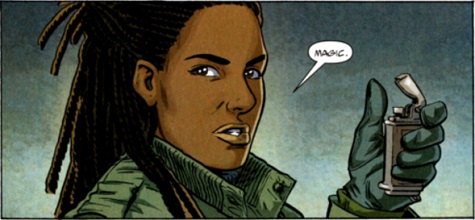For all their talk about diversity and inclusion, comic books still tend to be pretty straight, white, and male (and catered to same). But that doesn’t mean there aren’t a lot of great characters of color that do more than fill the token role. There are a ton of problematic ones (see: Tyroc), but just as many have been retconned into redemption or were lucky enough to start out on the awesome side. Black History Month is the perfect time to devote special attention to some great Black comic book characters, from BAMF humans to magic aliens to superheroes.
I admit there are a lot of people missing from this list, but that doesn’t mean they’re forgotten. It just means that this post was getting long and unwieldy, so it was either write a ridiculous longread of 30+ characters or cut it down to something more manageable. So instead of a Best Of list, you’re getting my top ten favorite Black characters. And if you want to tell me what a tragedy it is that Sam Wilson or Luke Cage or anyone else aren’t here, well, that’s what the comments section is for. Keep in mind, quite a few (like Renee Montoya and Dee) will turn up in Pull Lists for Women’s History Month and Pride in the upcoming months…
Be warned: minor spoilers ahoy.
Agent 355
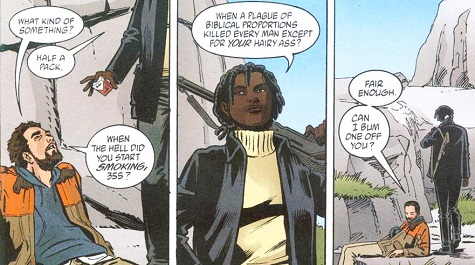
Creators: Brian K. Vaughan, Pia Guerra
Origin: Y: The Last Man #1, 2002, Vertigo
Unintentional as it was, we’re starting this post off with my all-time favorite comic book character. “Three-fifty” is the tenth iteration of Agent 355 from the Culper Ring (a real organization) and is sent to protect Yorick Brown, one of only two males left on the planet after a mysterious plague kills them all. Their friendship grows and deepens, and soon they are inseparable. Agent 355 is tough, clever, skilled, and risks everything for what she believes in, even if others disagree. She has total recall, fights equally well with a baton as with a gun, and takes no guff. But she isn’t cold or emotionally distant, rather she’s complex and messy.
In other words, she’s utterly, completely, painfully human in that way only Brian K. Vaughan seems to be able to write. She knits for Hera’s sake, and if the thought of a killer bodyguard knitting a rifle cozy during the apocalypse isn’t adorable, I don’t know what is. Just thinking about her makes me happy to live in a world where she exists, even if it’s only on paper. Agent 355 is right up there with Ianto, Wash, and Joyce Summers as a character I will never get over for the rest of my life. And now if you’ll excuse me, I have to go re-read Y: The Last Man for the zillionth time.
Amanda “The Wall” Waller
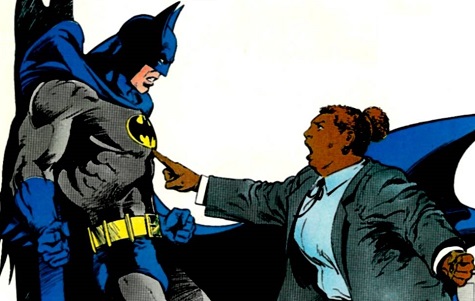
Aliases: White Queen, Black King, Mockingbird
Creators: Len Wein, John Ostrander, John Byrne
Origin: Legends #1, 1986, DC
You want a badass Black woman? You got one. Amanda Waller took the anguish from her husband and daughter’s murders and funnelled them into becoming a force to be reckoned with. It’s a cheat to say she’s DC’s version of Nick Fury, because if Waller was in Fury’s place, she’d have that Civil War nonsense locked down before it even started. She has an eye for manipulation and political maneuvering, and worked her way up from nothing to running the Suicide Squad. Waller understands that sometimes you have to do bad things to save good people, and if someone has to do it, it might as well be her.
Waller was yet another victim of The New 52’s egregious retconning—she was dramatically slimmed down and prettied up—but in my heart of hearts she will always the woman in the pic above, a large, bold, take no shit, get it done woman. Every Black person knows a Black woman like Waller. We all have one in our families, and I think that’s why I love her so much. She reminds me in many ways of my late grandmother, size and all. But the best part about Amanda Waller is yet to come. I CAN. NOT. WAIT. to see Viola Davis take on “The Wall.”
David Alleyne
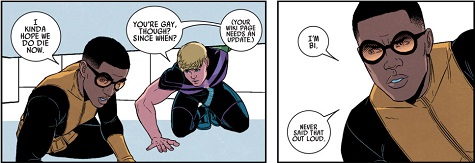
Alias: Prodigy
Creators: Nunzio DeFilippis, Christina Weir, Keron Grant
Origin: New Mutants vol 2 #4, 2003, Marvel
Our first mutant on this list but not the last, Prodigy has the ability to mimic the abilities of those around him, but only for a short time. At first he keeps his powers secret, using them to excel in school, until he’s outed by a bunch of anti-mutant jerkwads in college. He transfers to the Xavier Institute for Higher Learning, but resists joining the X-Men. It all comes crashing down with the “Decimation” arc after House of M, when Scarlet Witch strips nearly every mutant of their powers.
I boarded the Prodigy train with Kieron Gillen and Jamie McKelvie’s Young Avengers run, and their take on him is so great that I never to decided go back and read the previous iterations. The bad part is that means no more Prodigy for me, as Gillen and McKelvie are, for all intents and purposes, done with their run on the series. I could go on and on about this series, but suffice it to say it’s nearly perfect YA. What makes Prodigy in particular so great is that he’s such a twenty-something. He’s smarter than everyone around him yet routinely underappreciated. He’s bored silly, but has to be pushed to do something about it. He’s endearing, secretive, frustrated, and contemplative. And he has an unmitigated crush on someone he can never have. That attraction leads him to come out as bisexual, making him one of only a handful of bi—and bi PoC—characters in comic books.
Gwendolyn
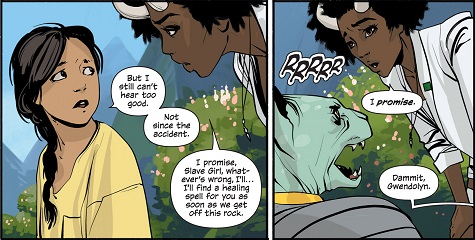
Creators: Brian K. Vaughan, Fiona Staples
Origin: Saga #8, 2012, Image
Saga is a story far too intricate to explain in a few sentences and still do it justice, but needless to say, if you haven’t read it yet, dude, get on it. Gwendolyn is Marko’s jilted fiancée. Wreath High Command hires The Will to kill Alana and Marko and bring their halfbreed back alive, and when he fails to get the job done in a timely fashion, Gwendolyn is sent to keep him on task. They tangent off course to rescue Sophie, a six-year-old sex slave, which leads to another detour of poison and near-fatal injuries (and also reveals her as bisexual). When Gwendolyn finally has her chance to hurt Marko as much as he hurt her, she finds that revenge isn’t as satisfying as she hoped.
Gwendolyn is a tricky one. At first I disliked her. We’ve all seen characters like her before, the harpy ex girlfriend who gets her heart broken and becomes a villain as she seeks revenge on the hero. It wasn’t so much Gwendolyn herself I disliked, but the trope she represents. But I kept faith that Brian K. Vaughan wouldn’t let me down, and sure enough she’s become one of my most beloved of the Saga characters. Yes, she’s the spurned ex lover, but that’s not the sum total of her personality. Like Agent 355, she’s full of contradictions, quirks, and foibles. She’s set herself on a path she doesn’t necessarily want to be on, and when given the opportunity to forge her own way she takes it. Along the way she falls for someone else, a man equally as undeserving of her love as Marko was, but one more worthy of it. Gwendolyn has gone from a trope to a trope breaker. I’d give anything for a spin off series of her, Sophie, and Lying Cat wandering the galaxy looking for cures for The Will.
Kamau Kogo and Penelope Rolle
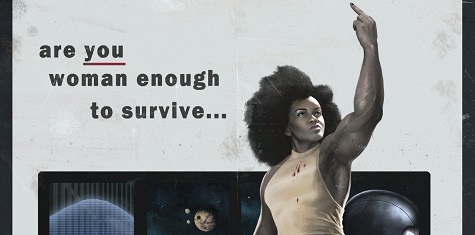
Creators: Kelly Sue DeConnick, Valentine De Landro
Origin: Bitch Planet #1, 2015, Image
I vacillated about whether to include Kam and Penny here or hold them until next month’s Women’s History column, but dammit, I just couldn’t wait. I want to talk about Bitch Planet all the time. I’m literally stopping people on the street to explain why it’s the best thing to happen to comics since the invention of the panel. We haven’t gotten much about Kam’s past but tantalizing hints, and Penny’s backstory won’t be told until issue #3 (releases Feb. 18!) but they’ve already won me over. Kam is a woman with a grudge, Penny is a punching machine, and neither give a fuck what the patriarchy thinks. I want to know everything about them and to spend as much time with them as humanly possible. Seriously, I’m practically jumping out of my seat to find out how Penny ended up in on the Auxiliary Compliance Outpost and how Kam intends to bust out of it.
I don’t even know how to describe how I feel about Penny and Kam, about Bitch Planet, about Kelly Sue DeConnick, but I know that I’ve read each issue a dozen times and they improve on each reading. And it’s absolutely crucial that a comic book as feminist as Bitch Planet stars women of color—and has white women as their prison supervisors. Kelly Sue and Val aren’t just talking about feminism, but about how queer, color, and trans women are often shut out of mainstream (read: white, cis, middle-class) feminism. As a woman of color, I’m glad to let Kam and Penny speak on my behalf.
Michonne
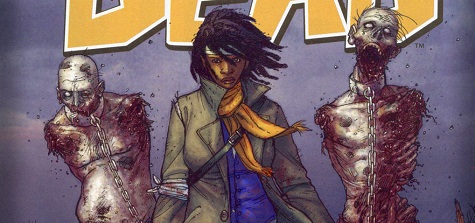
Creators: Robert Kirkman, Tony Moore, Charlie Adlard
Origin: The Walking Dead #19, 2005, Image
In the comics, Michonne is an ex-lawyer with a fencing background , a healthy sexual appetite, and a willingness to do the worst things for the betterment of the group. On TV, much of her darkest traits from the comics have been pushed onto Carol, and she’s far too emotionally distant for romantic intimacy, but both Michonnes are great women, and especially great Black women. To be a Black woman in America means constantly dealing with a toxic mix of racism and sexism, and Michonne is no different. She suffers horrific sexual violence at the hands of The Governor, and, later, Negan decides not to bash her brains in both because she’s Black—he jokes that he doesn’t want to seem racist—and because she’s a woman—he intends to rape her instead. While the villains of TWD are content to reduce her to a second class citizen, she takes great satisfaction in punishing them for it.
On TV, Michonne is the only zombie apocalypse survivor we’ve seen that figured out how to walk amongst the roamers without being bothered (and it’s worth noting that Carol is the only one of Rick’s group smart enough to remember to use Michonne’s tricks to her advantage). In both formats, she fights with efficient brutality, and protects those she cares for like a lioness. But she’s also has flaws, especially her need for vengeance and insistence on others matching her toughness. She’s a badass but not invulnerable, and her deadly actions haunt her to this day. There’s a reason she’s the most capable of the group in the comic books and television show.
Miles Morales
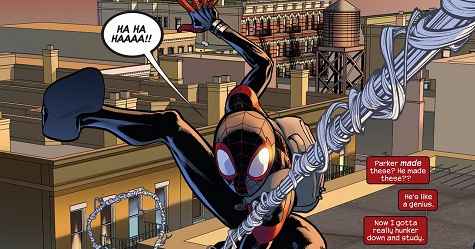
Alias: Spider-Man
Creators: Brian Michael Bendis, Sara Pichelli
Origin: Ultimate Fallout #4, 2011, Marvel
Miles holds the intriguing position of being the first Black and second Latino Spider-Man. For all you Community fans out there, Bendis was inspired to create him thanks to the push to cast Donald Glover in the role Andrew Garfield eventually got. Miles was only 13 when he was bitten by a genetically-modified spider not long after Peter Parker’s death. At first he’s more than a little reluctant to take over for Peter, not least of which because he’s afraid, but eventually he’s accepted into the Spider Family, including by Earth-616 Peter (ah, the joys of the multiverse).
Miles Morales isn’t just a cool Black superhero, he’s also the star of a really fun series. I never cared for Peter Parker—he is sooo profoundly lame and boring—but I’ll take all the Miles Morales Bendis and David Marquez have. Alright, so the series has some plotting issues, but, gosh darnit, I like spending time with Miles. He’s such a dork, in the most cheek-pinching way. His loser-ness is endearing in a way I never felt for Peter Parker. More importantly, there’s a whole gaggle of non-white teenagers out there who are getting Miles as their first superhero of color, and that’s frakking awesome. They’re growing up with him and the notion that PoC can star in their own series. Unfortunately, they’re also dealing with the douchecanoes complaining that Spider-Man can’t be Black because blah blah racist argle bargle blah. And while I’d rather have a wholly new Black superhero instead of constantly handing mantles over or shunting them off to parallel universes, I’m still happy Miles is here.
Ororo Munroe
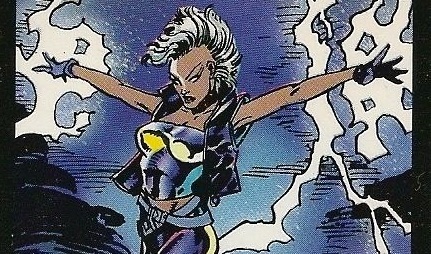
Alias: Storm
Creators: Len Wein, Dave Cockrum
Origin: Giant-Size X-Men #1, 1975, Marvel
All hail Storm, the Weather Witch, Mistress of the Elements, Goddess of the Plains, and Queen of Wakanda. Chances are if you’re a girl into comics, there was a chunk of time when you were obsessed with Storm. When I was a kid, I would’ve paid any amount of money to spend even a day with Storm (and Jubilee). Her powers—she can control weather, fly, is immune to extreme temperatures and telepathy, is empathetic to nature, and can do magic, not to mention her skills at strategy, piloting aircraft, and physical combat—are as vast and varied as the honorifics bestowed upon her. And she deserves every one of them. Storm was the first Black woman and one of the first Black characters in general in the Big Two. In many ways she’s the Marvel equivalent of Wonder Woman, the female superhero who kicks all kinds of ass and stands up to and knocks down the mightiest of men, and how cool is it that on top of all that she’s Black. She’s my superhero, you know? Freyja knows she isn’t perfect, but she’s still worth looking up to. Why Hollywood continues to crank out mediocre Wolverine movies rather than make an awesome Storm movie is beyond me. The new all-female Avengers team is the perfect opportunity…
Tanya Spears
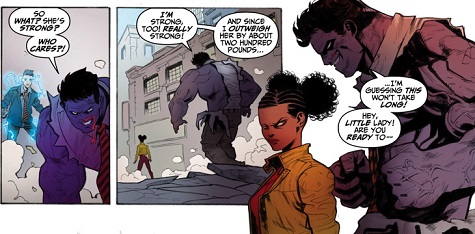
Alias: Power Girl
Creator: Paul Levitz
Origin: World’s Finest #23, 2014, DC
“The world’s smartest seventeen-year-old” is the daughter of the late Somya Spears, BFF to the last Power Girl, Karen Starr. When Karen jumped back to her original dimension, she bequeathed her super strength, invulnerability, and mantle (and maybe more…) to Tanya. She joins the Teen Titans in issue #6, and thank Batman she does. The New 52 version of Teen Titans do not do it for me. Just thinking about what Scott Lobdell and Kenneth Rocafort did to Starfire makes me want to HULK SMASH something.
Simply by ditching that awful boob window on the Power Girl suit, Tanya Spears is already streets ahead of her predecessor, and her personality solidifies it. She doesn’t show off her powers but won’t hesitate to use them, and she’s perfectly happy to let men underestimate her if it means kicking the crap out of them afterward. (Just look at that epic side-eye in the cover pic. Damn, girl!) She’s desperate to use her powers for good, but she also believes in going after the root of the problem rather than the offshoots. The men in the team seem content to run their scams on S.T.A.R. Labs, but the women have bigger fish to fry. Tanya is the only reason I’m now reading Teen Titans, and, frankly, I’d rather see her get fleshed out in a solo series. Or, even better, team up with Batgirl. Now that I’d pay good money for.
Victor “Vic” Stone and Karen Beecher
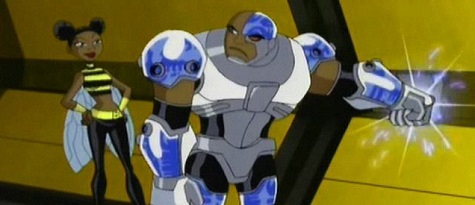
Aliases: Cyborg and Bumblebee
Creators: Marv Wolfman, George Pérez; Bob Rozakis
Origins: DC Comics Presents #26, 1980, DC; Teen Titans #45, 1976, DC
I have to admit something here: I’ve never actually read a Cyborg or Bumblebee storyline. I couldn’t tell you a single thing about the comic book characters. TBH I didn’t even realize they WERE from comic books until fairly recently—I know, I know, I’m a terrible fan. No, I want to talk about Cyborg and Bumblebee from the television show Teen Titans (the great mid-Aughts cartoon, not that Teen Titans Go! natter). I was in college when it premiered, but it proved to be one of those shows where my entire circle of friends independently discovered and got hooked on. We’d colonize the TV room in the dorm hall to watch mini marathons—this is was back in ancient times when DVRs were for rich people, DVD box sets were only for classic shows, and you just had to wait for a channel to announce reruns to catch up on any eps you may have missed.
By that time I had long given up on comic books, because even though I didn’t have the SJW vocabulary yet, I knew I hated how women were either sexualized or ignored (and frequently both), and that WoC never really got anything to do. So I was uber excited to see a comics-adjacent property with a Black person in a lead role, and by season three having an entire arc based on him. Even better, that same season introduced Bumblebee, whom I hold in the same adoring regard as Jubilee. Bumblebee was the first time I remember seeing a Black woman close to my own age in either an SFF or comic book capacity who was more than a background character. And to top it off, both had engaging personalities, dynamic agency, and interesting storylines. Representation matters, yo. Maybe I’ll read their comic book versions one day, but for now I’m content with fondly remembering the TV show.
Alex Brown is an archivist, research librarian, writer, geeknerdloserweirdo, and all-around pop culture obsessive who watches entirely too much TV. Keep up with her every move on Twitter and Instagram, or get lost in the rabbit warren of ships and fandoms on her Tumblr.
<!–










